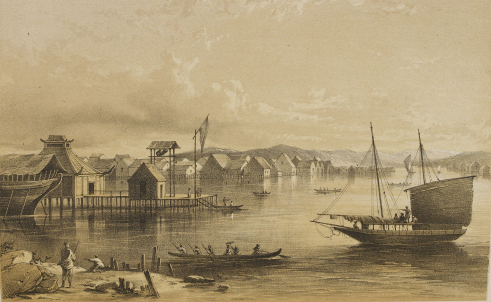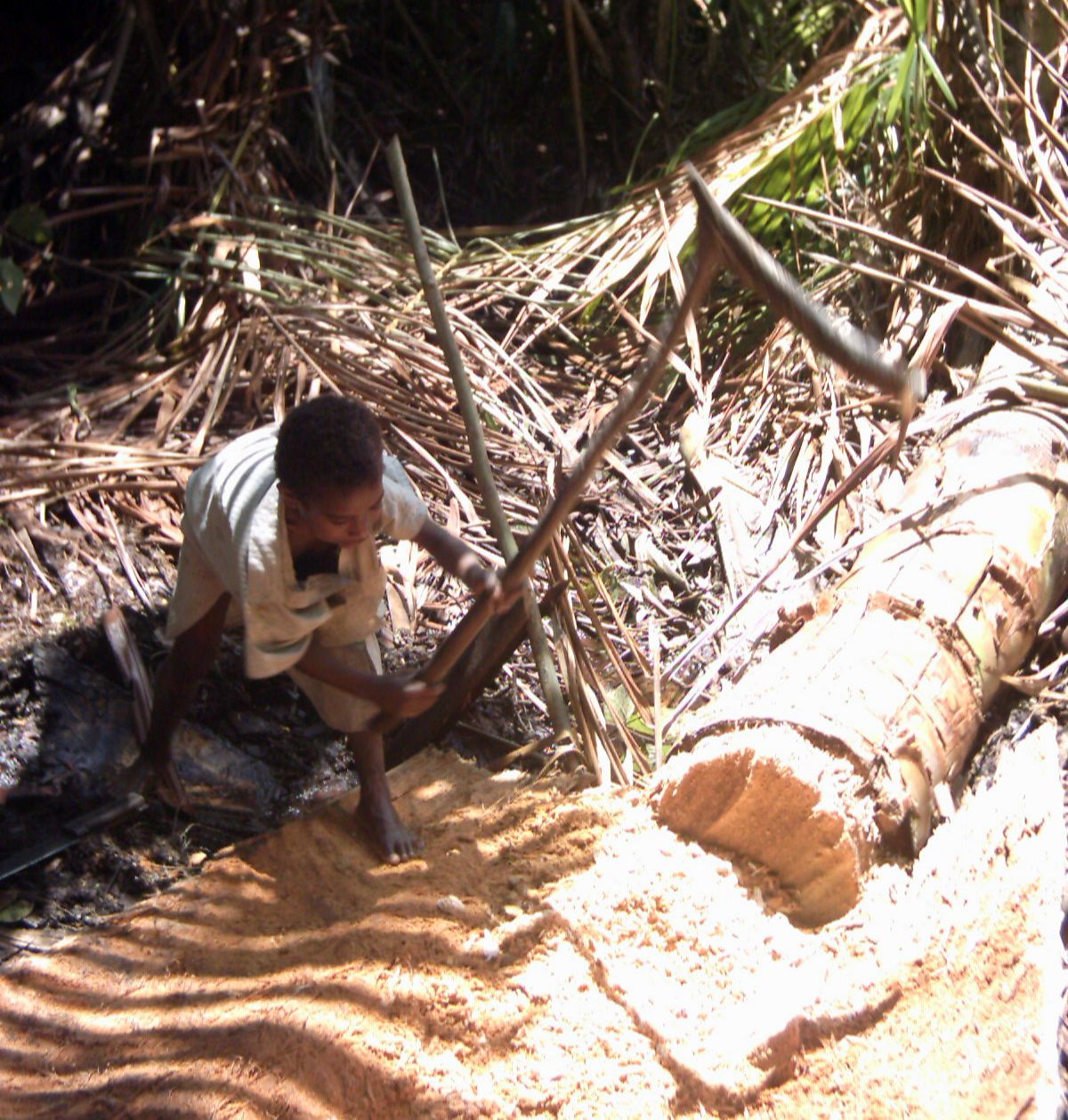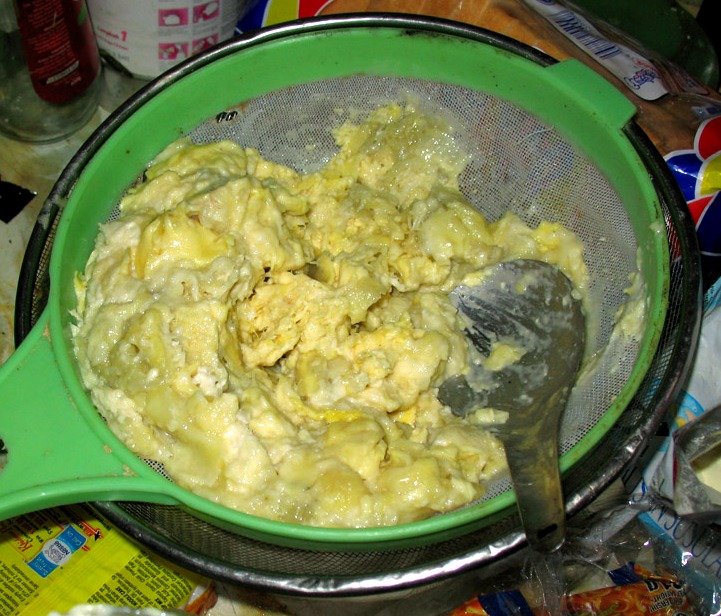|
Ambuyat
Ambuyat is a dish derived from the interior trunk of the sago palm. It is a starchy, bland substance similar to tapioca. Ambuyat is the national dish of Brunei, and it is also popular in the Malaysian states of Sarawak and Sabah as well as the federal territory of Labuan, where it is sometimes known as ''linut''. Background Ambuyat is the traditional food of the Bruneian Malay, Bisaya, Bajau, Kadazan-Dusun, and Lundayeh/Lun Bawang people in both the Interior Division and West Coast Division of Sabah and the Limbang Division of Sarawak, as well as the Malaysian federal territory of Labuan and the sultanate of Brunei, where it is considered the national dish. Ambuyat is eaten with a linked pair of bamboo chopsticks called ''chandas'', by rolling the starch around the prongs and then dipping it into a sauce, of which there are many varieties, including shrimp paste (''sambal belacan''), ''sambal tempoyak'' (chilli and fermented durian paste), ''sambal cincalok'' (ch ... [...More Info...] [...Related Items...] OR: [Wikipedia] [Google] [Baidu] |
National Dish
A national dish is a culinary Dish (food), dish that is strongly associated with a particular country. A dish can be considered a national dish for a variety of reasons: * It is a staple food, made from a selection of locally available foodstuffs that can be prepared in a distinctive way, such as ''fruits de mer'', served along the west coast of France. * It contains a particular ingredient that is produced locally, such as a paprika grown in the European Pyrenees. * It is served as a Festival, festive culinary tradition that forms part of a cultural heritage—for example, barbecues at summer camp or fondue at Party#Dinner party, dinner parties—or as part of a Religion, religious practice, such as Korban Pesach or Iftar celebrations. * It has been promoted as a national dish, by the country itself, such as the promotion of fondue as a national dish of Switzerland by the Swiss Cheese Union (Schweizerische Käseunion) in the 1930s. National dishes are part of National identity, a ... [...More Info...] [...Related Items...] OR: [Wikipedia] [Google] [Baidu] |
Papeda (food)
Papeda, or ''bubur sagu'', is a type of congee made from sago starch. It is a staple food of the people indigenous to Eastern Indonesia, namely parts of Sulawesi, the Maluku Islands and coastal Papua. It is also widespread in Papua New Guinea and serves as the counterpart to central and western Indonesian cuisines that favour rice as their staple food. The starch is acquired by felling the trunk of a sago palm tree, cutting it in half, and scraping the soft inner parts of the trunk, the pith, producing a crude sago pith flour. This flour is then mixed with water and squeezed to leach the starch from the flour. The still-moist sago starch is usually stored in a container made of sago palm leaflets, called ''tumang'', in which it will keep for several months before spontaneous fermentation will turn it too acidic and unsuitable for making papeda. Depending on the variety and the growing conditions, it may take a sago tree five to over ten years to accumulate enough starch i ... [...More Info...] [...Related Items...] OR: [Wikipedia] [Google] [Baidu] |
Bruneian Malay People
Bruneian MalaysBrunei Malay in its various forms can be identified with a nation, an ethnic group and a region. (, Jawi alphabet, Jawi: ) are a native Malays (ethnic group), Malay ethnic group that lives in Brunei, the Federal Territories of Malaysia, federal territory of Labuan, the southwestern coast of Sabah and the northern parts of Sarawak. The Bruneian Malays are a subgroup of the larger ethnic Malays (ethnic group), Malay population found in the other parts of the Malay World, namely Peninsular Malaysia and the central and southern areas of Sarawak including neighbouring lands such as Singapore, Indonesia and Southern Thailand, having visible differences especially in language and culture, even though they are ethnically related to each other and follow the teachings of Islam. All Bruneian Malays who are born or domiciled in East Malaysia even for generations before or after the independence of the states of Sabah and Sarawak from the British Empire through the formation ... [...More Info...] [...Related Items...] OR: [Wikipedia] [Google] [Baidu] |
Bandar Seri Begawan
Bandar Seri Begawan (BSB) is the capital and largest city of Brunei. It is officially a Municipalities of Brunei, municipal area () with an area of and an estimated population of 100,700 as of 2007. It is part of Brunei–Muara District, the smallest yet most populous district which is home to over 70 percent of the country's population. It is the country's largest urban centre and nominally the country's only city. The capital is home to Brunei's seat of government, as well as a commercial and cultural centre. It was formerly known as Brunei Town until it was renamed in 1970 in honour of Omar Ali Saifuddien III, the 28th Sultan of Brunei and the father of Sultan Hassanal Bolkiah. The history of Bandar Seri Begawan can be traced back to the establishment of a Bruneian Malay people, Malay stilt settlement on the waters of the Brunei River which became the predecessor of Kampong Ayer today. It became the capital of the Bruneian Sultanate (1368–1888), Bruneian Sultanate from the ... [...More Info...] [...Related Items...] OR: [Wikipedia] [Google] [Baidu] |
Sago
Sago () is a starch extracted from the pith, or spongy core tissue, of various tropical palm stems, especially those of ''Metroxylon sagu''. It is a major staple food for the lowland peoples of New Guinea and the Maluku Islands, where it is called ''saksak'', ''rabia'' and ''sagu''. The largest supply of sago comes from Melanesia region, particularly Eastern Indonesia. Large quantities of sago are sent to Europe and North America for cooking purposes. It is traditionally cooked and eaten in various forms, such as rolled into balls, mixed with boiling water to form a glue-like paste (Papeda (food), papeda), or as a pancake. Sago is often produced commercially in the form of "pearls" (small rounded starch aggregates, partly Starch gelatinization, gelatinized by heating). Sago pearls can be boiled with water or milk and sugar to make a sweet sago pudding. Sago pearls are similar in appearance to the pearled starches of other origin, e.g. cassava starch (tapioca) and potato starch ... [...More Info...] [...Related Items...] OR: [Wikipedia] [Google] [Baidu] |
Chopsticks
Chopsticks are shaped pairs of equal-length sticks that have been used as kitchen and eating utensils in most of East Asia for over three millennia. They are held in the dominant hand, secured by fingers, and wielded as extensions of the hand, to pick up food. Originating in China, chopsticks later spread to other parts of continental Asia. Chopsticks have become more accepted in connection with East Asian food in the West, especially in cities with significant East Asian diaspora communities. The use of chopsticks has also spread to the rest of Southeast Asia either via the Chinese diaspora or through some dishes such as noodles that may require chopsticks. Chopsticks are smoothed, and frequently tapered. They are traditionally made of wood, bamboo, metal, ivory, and ceramics, and in modern days, increasingly available in non-traditional materials such as plastic, stainless steel, and even titanium. Chopsticks are often seen as requiring practice and skill to master to be ... [...More Info...] [...Related Items...] OR: [Wikipedia] [Google] [Baidu] |
Tempoyak
Tempoyak (Jawi script, Jawi: ), asam durian or pekasam is a Malay cuisine, Malay condiment made from Fermentation in food processing, fermented durian. It is usually consumed by the ethnic Malays in Maritime Southeast Asia, notably in Indonesia and Malaysia. Tempoyak is made by crushing durian flesh and mixing it with some salt and kept in room temperature from three to seven days for fermentation. Tempoyaks are usually made during the durian season, when the abundance of durian and excess production are made into fermented tempoyak. Tempoyak is not normally consumed on its own; it is usually eaten as condiment or as an ingredient for cooking, such as when it is cooked with coconut milk curry as ''gulai tempoyak ikan patin'' (pangasius fish tempoyak curry), or mixed with spicy chili pepper as ''sambal tempoyak''. Fermentation In the Malay Archipelago, fermented durian is known by many names. It is commonly known as ''tempoyak'' in the Malay Peninsula, Borneo, and Southern Sumatr ... [...More Info...] [...Related Items...] OR: [Wikipedia] [Google] [Baidu] |
Shrimp Paste
Shrimp paste or prawn sauce is a Fermentation, fermented condiment commonly used in Southeast Asian cuisine, Southeast Asian and Coastal Chinese cuisines. It is primarily made from finely crushed Shrimp and prawn as food, shrimp or krill mixed with salt, and then fermented for several weeks. It is sold either in its wet form or sun-dried and either cut into blocks or sold in bulk. It is an essential ingredient in many curry, curries, sauces and sambal. Shrimp paste can be found in many meals in Cambodia, Indonesia, Laos, Malaysia, Myanmar, Philippines, the Philippines, Singapore, Thailand, and Vietnam. It is often an ingredient in Dip (food), dip for fish or vegetables. History Shrimp paste originated in continental Southeast Asia, probably among the Cham people, Cham and Mon people, from where it spread southwards to insular Southeast Asia. In Java, fermented shrimp paste (''trasi'' or ''terasi''), as mentioned in two ancient Sundanese language, Sundanese scriptures, ''Car ... [...More Info...] [...Related Items...] OR: [Wikipedia] [Google] [Baidu] |
Mangifera Indica
''Mangifera indica'', commonly known as mango, is an evergreen species of flowering plant in the family Anacardiaceae. It is a large fruit tree, capable of growing to a height and width of . There are two distinct genetic populations in modern mangoesthe "Indian type" and the "Southeast Asian type". Description ''Mangifera indica'' is a large green tree, valued mainly for its fruits, both green and ripe. Approximately 500-1000 varieties have been identified, named, or reported, primarily in India. It can grow up to tall with a similar crown width and a trunk circumference of more than . The leaves are simple, shiny and dark green. The trees take 2-4 years from planting time to first harvest, and can have a productive life of over 50 years. Yellow-white fragrant flowers appear at the end of winter through the beginning of spring, varying with location. Both male and female flowers are borne on the same tree. Climatic conditions have a significant influence on the time of flower ... [...More Info...] [...Related Items...] OR: [Wikipedia] [Google] [Baidu] |
Durian
The durian () is the edible fruit of several tree species belonging to the genus ''Durio''. There are 30 recognized species, at least nine of which produce edible fruit. ''Durio zibethinus'', native to Borneo and Sumatra, is the only species available on the international market. It has over 300 named varieties in Thailand and over 200 in Malaysia as of 2021. Other species are sold in their local regions. Known in some regions as the "king of fruits", the durian is distinctive for its large size, strong odour, and Spine (botany), thorn-covered peel (fruit), rind. The fruit can grow as large as long and in diameter, and it typically weighs . Its shape ranges from oblong to round, the colour of its husk from green to brown, and its flesh from pale yellow to red, depending on the species. Some people regard the durian as having a pleasantly sweet fragrance, whereas others find the aroma overpowering and unpleasant. The persistence of its strong odour, which may linger for sev ... [...More Info...] [...Related Items...] OR: [Wikipedia] [Google] [Baidu] |
Cincalok
Cincalok ( Jawi: چنچالوق), also ''cencaluk'', is a Malay condiment that originated in Malacca, Malaysia, consumed by Malays, Peranakans and Kristangs. Its origins can be traced back to the Portuguese occupation of Malacca. This condiment consists of fermented small shrimp or krill, which are called ''udang geragau'' in Melaka and are easily identifiable in the mixture. It is predominantly salty in taste, and is usually served together with chillis, shallots and lime juice. Sir R. O. Winstedt has written about "Cencaluk" in Malaysia in his book "The Circumstances of Malay Life - 1909". This shrimp is seasonally available in Pantai Klebang, Limbongan, Tanjung Kling and several coastal areas. Presently, cincalok making enterprises are gaining ground in several areas in the state of Melaka. The state government itself has designated the State Legislative Assembly constituency Sungai Udang as the area to produce cincalok in the 'Satu DUN Satu Produk' plan. Apart ... [...More Info...] [...Related Items...] OR: [Wikipedia] [Google] [Baidu] |







